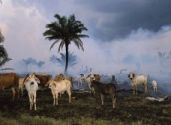
Warnings About Food and Its Consequences: 2008

73 million and counting
News about food—and its consequences—has been coming fast and furious. The World Food Program warns that demand for biofuels and meat is pushing up food prices, threatening more people in the global south with acute hunger. (See previous blog). A new report from Friends of the Earth-Brazilian Amazon has this alarming news: despite many efforts to dissuade purchasers of “rainforest beef” the Brazilian Amazon is becoming an epi-center of cattle production. In 2007, for the first time, 10 million Amazonian cattle were slaughtered for meat. The total cattle population in the rainforest reached 73 million, according to the report. Brazil is now the world’s 2nd largest beef producer, after the U.S. (which buys significant amounts of Brazilian beef). Cattle numbers have risen by a third since 1996 and, at 200 million, outstrips Brazil’s human population.
The era of “cheap food” is over. Already, milk and meat prices are rising in the U.S. Economist Robert Samuelson, writing in the Washington Post, concedes that if this encourages people to eat fewer animal products, that is, eat healthier, that would be good. But he and others worry about farmers and eaters in the poorer regions of the world. Some may be rewarded’like those busy clearing the Amazon’by higher prices for commodity and feed crops. But at what cost to the local and global environment? The Amazon serves as the world’s lungs, capturing and clearing carbon dioxide. As forests and other indigenous vegetation are cleared, this capacity is reduced. Even as the Earth needs the Amazon more as the climate changes, some studies suggest that during this century the region could become a desert.
Many small-scale farmers and herders in the global south are already being hit hard by climate shocks (see earlier blog on cattle and climate). Drought, irregular rainfall and spreading deserts are more and more the norm. Most commodity crop farmers operate at large-scales. They’re corporations, not collectives. So poor farmers are being left out of the commodity boom, as they are out of the meat-consumption boom, even as precious natural resources like land and water are being used’in reality used up’further scrabbling prospects for equity and sustainability. Closer to home, a recent study from Tufts University’s Global Environment and Development Institute, demonstrates another crazy-quilt aspect of all of this. Industrial animal farms in the U.S. received a subsidy of $3.9 billion each year between 1997 and 2005, according to the report, because they paid below-cost for feed crops like corn and soy…because these crops were heavily subsidized by the U.S. government and overproduced by large commodity farmers (really corporations). That’s a $35 billion advantage to factory farms over the course of a decade’and the heart of U.S. farm policy.
Cheap food no longer looks so cheap. In reality, it never was. Instead, it was Big Ag, with U.S. government support, creating (to paraphrase a recent Bill Clinton line that, admittedly, didn’t go over so well) one of the biggest fairy tales we’ve ever seen. Now they’re taking that show on the road, trying to sell cheap food and mass production methods, including vast quantities of meat and dairy, in other parts of the world not yet saturated. Can they succeed? Population growth and environmental devastation, including the big kahuna of climate change, suggest they can’t. But the desire for new profit centers means they’ll try’very, very hard. Stay tuned, and attuned. In the meantime, stay nourished. Check out the PB&J campaign. It’s a home-grown effort to encourage Americans to eat fewer animals and animal products’and reduce their personal greenhouse gas emissions’by eating a peanut butter and jelly sandwich for lunch. (Soy milk is optional…this soy doesn’t come from the Amazon, at least not yet.)
 Brighter Green
Brighter Green



